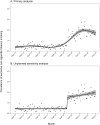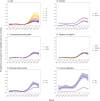Trends in Exclusive Non-Cigarette Tobacco Smoking in England: A Population Survey 2013-2023
- PMID: 38439612
- PMCID: PMC11750737
- DOI: 10.1093/ntr/ntae021
Trends in Exclusive Non-Cigarette Tobacco Smoking in England: A Population Survey 2013-2023
Abstract
Introduction: The UK Government intends to implement a "smokefree generation" policy prohibiting the sale of all tobacco products to people born after 2008. National surveys provide comprehensive data on cigarette smoking, but little is known about patterns of non-cigarette tobacco smoking across key population groups.
Aims and methods: Using data from a nationally representative cross-sectional survey of adults in England, collected monthly between September 2013 and September 2023 (n = 196 721), we estimated time trends in exclusive non-cigarette tobacco (eg, cigar/pipe/shisha) smoking prevalence, overall and by age, gender, occupational social grade, region, ethnicity, and vaping status. Interviews were conducted face-to-face until March 2020 and via telephone thereafter.
Results: From September 2013 to September 2023, there was a non-linear increase in exclusive non-cigarette tobacco smoking prevalence (from 0.36% to 1.68%; prevalence ratio = 4.72 [95% CI = 3.43-6.48]). Prevalence was relatively stable up to February 2020 (at an average of 0.46%), then increased sharply at the start of the COVID-19 pandemic (at the same time as survey methods changed), to 0.90% (0.82%-0.99%) in March 2020. This was followed by a steadier rise, peaking at 1.97% in May 2022, before falling slightly to 1.68% by September 2023. In 2022/2023, 1 in 10 smokers (10.8% [9.64%-12.0%]) exclusively used non-cigarette tobacco. The rise in prevalence was observed across all subgroups but was most pronounced among younger adults (eg, reaching 3.21% of 18-year-olds vs. 1.09% of 65-year-olds). Prevalence was consistently higher among men and current vapers.
Conclusions: Although exclusive use of non-cigarette combustible tobacco remains rare among adults in England, it has increased in recent years, particularly among younger ages. As of September 2023, there were approximately 772 800 adult exclusive non-cigarette tobacco smokers in England; around five times more than a decade earlier.
Implications: The proportion of adults in England who do not use cigarettes at all but smoke other combustible tobacco products has increased substantially in recent years, with a particularly pronounced rise among young people. The inclusion of non-cigarette combustible tobacco products under the proposed "smokefree generation" policy is therefore likely to be important for achieving the greatest reduction in youth uptake of tobacco smoking, as it would ensure young people who are unable to legally buy cigarettes do not buy other combustible tobacco products that are similarly harmful to health.
© The Author(s) 2024. Published by Oxford University Press on behalf of the Society for Research on Nicotine and Tobacco.
Conflict of interest statement
JB has received unrestricted research funding from Pfizer and J&J, who manufacture smoking cessation medications. LS has received honoraria for talks, unrestricted research grants, and travel expenses to attend meetings and workshops from manufacturers of smoking cessation medications (Pfizer; J&J), and has acted as a paid reviewer for grant awarding bodies and as a paid consultant for health care companies. All authors declare no financial links with tobacco companies, e-cigarette manufacturers, or their representatives.
Figures


Similar articles
-
Trends and patterns of dual use of combustible tobacco and e-cigarettes among adults in England: A population study, 2016-2024.Addiction. 2025 Apr;120(4):608-619. doi: 10.1111/add.16734. Epub 2025 Jan 22. Addiction. 2025. PMID: 39842468 Free PMC article.
-
Disposable E-Cigarette Use Prevalence, Correlates, and Associations With Previous Tobacco Product Use in Young Adults.Nicotine Tob Res. 2022 Feb 14;24(3):372-379. doi: 10.1093/ntr/ntab165. Nicotine Tob Res. 2022. PMID: 34379787 Free PMC article.
-
Association between changes in harm perceptions and e-cigarette use among current tobacco smokers in England: a time series analysis.BMC Med. 2020 May 6;18(1):98. doi: 10.1186/s12916-020-01565-2. BMC Med. 2020. PMID: 32370755 Free PMC article.
-
Smoking prevalence in the Eastern Mediterranean Region.East Mediterr Health J. 2020 Jan 30;26(1):94-101. doi: 10.26719/2020.26.1.94. East Mediterr Health J. 2020. PMID: 32043551 Review.
-
Preventing Tobacco Use Among Youth and Young Adults: A Report of the Surgeon General.Atlanta (GA): Centers for Disease Control and Prevention (US); 2012. Atlanta (GA): Centers for Disease Control and Prevention (US); 2012. PMID: 22876391 Free Books & Documents. Review.
Cited by
-
Use, perceptions, and effectiveness of e-cigarettes for smoking cessation among older adults in England: a population study, 2014-2024.BMC Med. 2024 Oct 31;22(1):500. doi: 10.1186/s12916-024-03728-x. BMC Med. 2024. PMID: 39482655 Free PMC article.
-
Roll-Your-Own Tobacco Use Among People Smoking Menthol Cigarettes in Great Britain, 2020-2023: A Population-Based Survey.Nicotine Tob Res. 2025 Jun 23;27(7):1200-1208. doi: 10.1093/ntr/ntae217. Nicotine Tob Res. 2025. PMID: 39252603 Free PMC article.
-
Trends and patterns of dual use of combustible tobacco and e-cigarettes among adults in England: A population study, 2016-2024.Addiction. 2025 Apr;120(4):608-619. doi: 10.1111/add.16734. Epub 2025 Jan 22. Addiction. 2025. PMID: 39842468 Free PMC article.
References
-
- Department of Health and Social Care. Stopping the Start: Our New Plan to Create a Smokefree Generation; 2023. https://www.gov.uk/government/publications/stopping-the-start-our-new-pl.... Accessed October 5, 2023.
-
- Office for National Statistics. Adult Smoking Habits in the UK: 2022; 2023. https://www.ons.gov.uk/peoplepopulationandcommunity/healthandsocialcare/.... Accessed September 7, 2023.
-
- Ng Fat L. Health Survey for England 2015: Adult Cigarette Smoking. NHS Digital; 2016. https://files.digital.nhs.uk/publicationimport/pub22xxx/pub22610/hse2015.... Accessed November 1, 2023.
-
- Fidler JA, Shahab L, West O, et al.“The smoking toolkit study”: a national study of smoking and smoking cessation in England. BMC Public Health. 2011;11:479. doi: https://doi.org/10.1186/1471-2458-11-479 - DOI - PMC - PubMed
MeSH terms
Grants and funding
LinkOut - more resources
Full Text Sources
Medical
Research Materials

